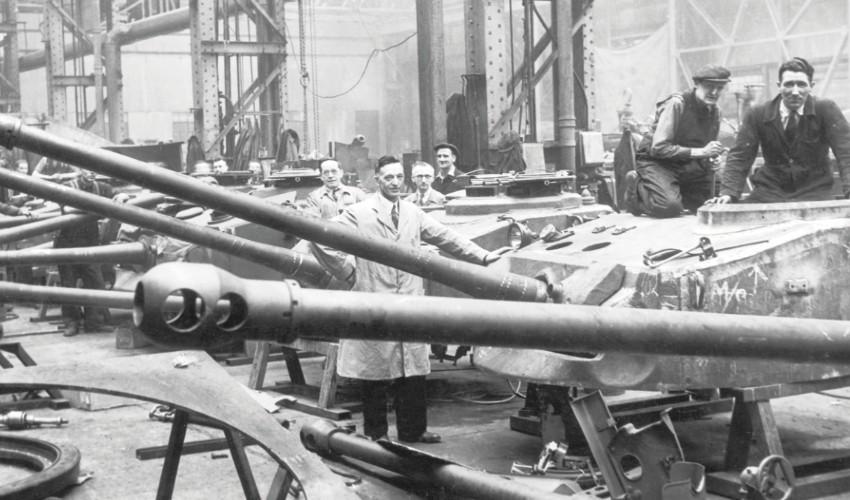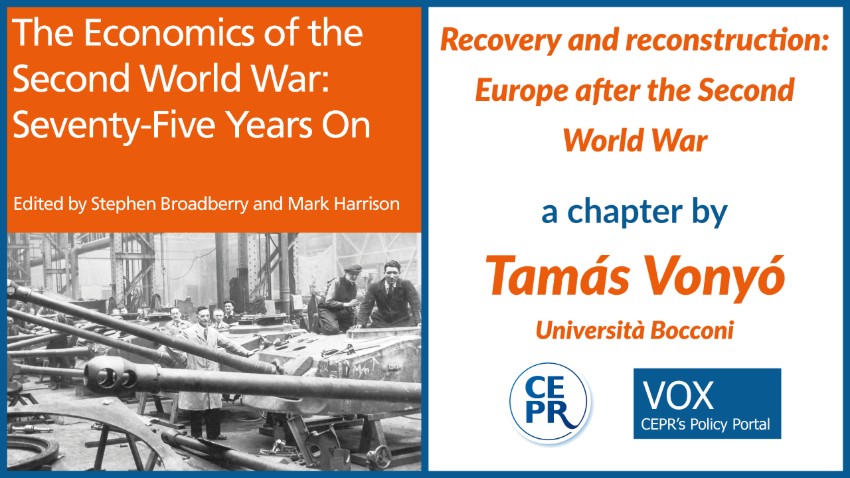
A Tale of Two Post War Recoveries
WESTERN AND EASTERN EUROPE EXPERIENCED LARGELY DIFFERENT ECONOMIC CONSEQUENCES OF WWII, TAMAS VONYO EXPLAINS IN A CHAPTER OF THE EBOOK CEPR AND VOXEU PUBLISH TO MARK THE 75TH ANNIVERSARY OF THE END OF THE CONFLICT IN EUROPEThe Second World War ended in Europe on this day 75 years ago. It was the worst of all wars and has been the most studied event in human history. To mark this anniversary, the Centre for Economic Policy Research in London published an e-Book on VoxEU, with contributions by leading scholars on the economics and the economic consequences of the war (Stephen Broadberry and Mark Harrison, eds, The Economics of the Second World War: Seventy-Five Years On, free ebook). Tamás Vonyó, Associate Professor at the Department of Social and Political Sciences and research fellow of the CEPR, authored the chapter on post-war recovery in Europe. Bocconi Knowledge publishes an excerpt of his chapter.
 |
| Stephen Broadberry and Mark Harrison, eds, The Economics of the Second World War: Seventy-Five Years On, free ebook |
The enormous firepower of industrial warfare and aerial bombardment brought physical destruction that few could have imagined and few imagined could be overcome in their lifetime. That a Europe more prosperous than ever would emerge from this apocalypse astonished the world. Most economies shattered by war returned to pre-war levels of output within five years. The quarter-century that followed would be engraved in collective memory as the most remarkable era of macroeconomic stability and social progress in the history of the western world and as the ‘golden age of economic growth’ in Europe, both East and West.
In Western Europe, the foundations of economic life remained strong. The casualties of war were more than offset by natural population growth and post-war mass migration. Despite the scale of material damage, industrial equipment and plants survived the war remarkably intact. Even in Germany and Italy, the two main targets of Allied strategic bombing, industrial fixed capital grew substantially. Power-generating capacity was also enlarged and needed little repair. Industrial production had been brought to a halt by the demolition of the transport infrastructure, in particular bridges and railway hubs. But the maintenance of wartime command-economy controls and warlike labour mobilisation swiftly eliminated these bottlenecks and avoided the acute shortages that might have fuelled social unrest and runaway inflation, as Europe had experienced at the end of World War I […] the resumption of economic growth was held back by institutional and geopolitical factors rather than the lack of productive capacity. The reconstruction of Western Europe required the abolition of the command economy and the liberalisation of prices and wages; the elimination of the dollar shortage to enable countries ravaged by war to import the capital goods necessary to rebuild their infrastructure and restock their factories; the restoration of the European division of labour; and international cooperation to resolve the German question and remobilise German industry. These prerequisites were impossible to achieve without constructive American leadership in the rebuilding of the post-war order […]
The brutality of the Eastern Front in World War II was apocalyptic and brought unprecedented destruction. The most devastating campaigns in global military history were fought over the ‘bloodlands’ stretching between Berlin and Stalingrad. Thousands of towns and villages were removed from the face of the Earth; tens of millions were made homeless. The human toll was incomparable to any other region of the world. Forty million Eastern Europeans died in the carnage, including more than five of the six million European Jews who perished in the Holocaust. From the invasion of the Soviet Union, Nazi Germany waged a war of extermination. The thirst for vengeance among the oppressed revealed itself in early 1945, when the Red Army rank and file ran amok in the eastern provinces of Germany, although Soviet soldiers often behaved similarly towards the ‘liberated’, too. Millions more fled west, either running from the advancing Soviet troops or defecting when the communist parties rose to power in the Eastern regions. The expulsion of ethnic Germans from Central and Eastern Europe after 1945 and forced population exchanges enhanced this exodus […]
While these population movements featured prominently in German historiography, their impact was largely ignored in the economic history of Eastern Europe. The demographic effect of war casualties, including those physically or psychologically disabled, combined with the post-war settlement, was devastating […] The shortage of labour, and especially of skills, was crushing […] Across Central and Eastern Europe, the war left behind a distorted demographic structure with a crippling shortage of able-bodied young men, who had constituted the backbone of the industrial workforce. The Holocaust and the expulsion of ethnic Germans, together with the mass voluntary exodus of the bourgeois middle class, bequeathed upon the tormented region a plethora of industrial and commercial enterprises without their original owners and the necessary skills and managerial know- how required to operate them.
The economic performance of the eastern half of Europe after 1945 can only be evaluated in light of these inauspicious beginnings. While communism and the command economy played their part, they are not the whole story. The initial conditions of economic recovery in Eastern Europe were also far less favourable than in the West.
by Tamas Vonyo
